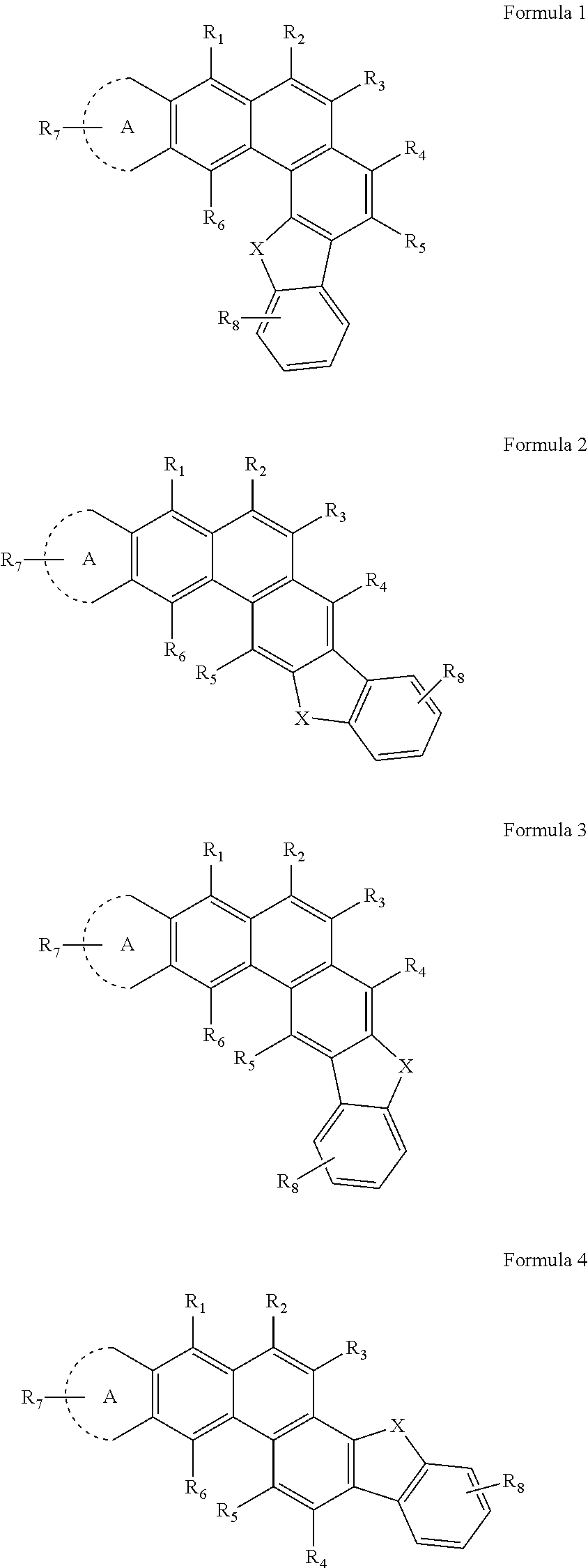Heterocyclic compound and organic light-emitting device including the same
a heterocyclic compound and organic light-emitting technology, applied in the direction of luminescent compositions, organic chemistry, chemistry apparatus and processes, etc., can solve the problems of poor efficiency, driving voltage, lifetime, etc., and achieve the effect of improving luminescence efficiency characteristics, low voltage, and high efficiency
- Summary
- Abstract
- Description
- Claims
- Application Information
AI Technical Summary
Benefits of technology
Problems solved by technology
Method used
Image
Examples
synthesis example 1
Representative Synthesis Example 1
Synthesis of Compounds 15-D
[0153]Compound 1 was synthesized according to Reaction Scheme 1 below.
[0154]
Reaction Scheme 1: Synthesis of Intermediate 15-Da
[0155]22 g of 3-Iodo-9-phenyl-9H-carbazole, 2.8 g (0.04 eq) of Pd(PPh3)4, and 914 mg (0.08 eq) of CuI were put into a flask, which was then supplied with N2 gas in a vacuum. After 200 mL of tetrahydrofuran (THF) was added into the flask and then stirred, 10 mL (1.2 eq) of triethylamine and 10.0 g (1.2 eq) of TMS-acetylene were slowly dropwise added thereinto and then stirred at room temperature for about 2 hours in a N2 atmosphere. After removing the solvent using a rotary evaporator, the resulting reaction product was extracted two times each with 200 mL of Et2O and 150 mL of water. The ether phase was collected and dried using magnesium sulfate, and the solvent was evaporated. The residue was separated and purified using silica gel column chromatography to obtain 20 g of Intermediate 15-Da with a ...
synthesis example 2
Representative Synthesis Example 2
Synthesis of Compound 16-H
[0168]
Reaction Scheme 6: Synthesis of Intermediate 16-Ha
[0169]Intermediate 16-Ha was synthesized in the same manner as in Reaction Scheme 3 using the same equivalents of reactants, except that Compound 10 and Intermediate F were used. The yield was about 58%, and this compound was identified using liquid chromatography-mass spectroscopy (LC-MS). C22H11Br1O1S1: M+403.97
Reaction Scheme 7: Synthesis of Intermediate 16-Hb
[0170]Intermediate 16-Hb was synthesized in the same manner as in Reaction Scheme 4 using the same equivalents of reactants, except that Intermediate 16-Ha and Compound 6 were used. The yield was about 72%, and this compound was identified using LC-MS. C34H18O2S1: M+490.10
Reaction Scheme 8: Synthesis of Intermediate 16-Hc
[0171]7.9 g (2 eq) of bis(pyridine)iodonium tetrafluoroborate and 80 ml of dichloromethane were mixed together, and 3.11 mL (0.002 eq, d 1.696) of CF3SO3H was added thereto and stirred at about...
example 1
[0180]To manufacture an anode, a corning 15 Ω / cm2 (1200 Å) ITO glass substrate was cut to a size of 50 mm×50 mm×0.7 mm, then sonicated in isopropyl alcohol and pure water each for five minutes, and then cleaned by irradiation of ultraviolet rays for 30 minutes and exposure to ozone. The resulting glass substrate was loaded into a vacuum deposition device.
[0181]Then, 4,4′,4″-tris(N-(2-naphthyl)-N-phenylamino)triphenylamine (2-TNATA), which is a HIL material, was vacuum-deposited on the glass substrate to form a HIL having a thickness of about 600 Å. Then, 4,4′-bis[N-(1-naphthyl)-N-phenylamino]biphenyl (NPB), which is a hole transporting compound, was vacuum-deposited on the HIL to form a HTL having a thickness of about 300 Å.
[0182]
[0183]9,10-Di-naphthalene-2-yl-anthracene (DNA) as a blue fluorescent host and the synthesized Compound 46-E as a blue fluorescent dopant (instead of known blue fluorescent dopant) were co-deposited on the HTL in a weight ratio of 98:2 to form an EML having...
PUM
| Property | Measurement | Unit |
|---|---|---|
| pressure | aaaaa | aaaaa |
| temperature | aaaaa | aaaaa |
| temperature | aaaaa | aaaaa |
Abstract
Description
Claims
Application Information
 Login to View More
Login to View More - R&D
- Intellectual Property
- Life Sciences
- Materials
- Tech Scout
- Unparalleled Data Quality
- Higher Quality Content
- 60% Fewer Hallucinations
Browse by: Latest US Patents, China's latest patents, Technical Efficacy Thesaurus, Application Domain, Technology Topic, Popular Technical Reports.
© 2025 PatSnap. All rights reserved.Legal|Privacy policy|Modern Slavery Act Transparency Statement|Sitemap|About US| Contact US: help@patsnap.com



